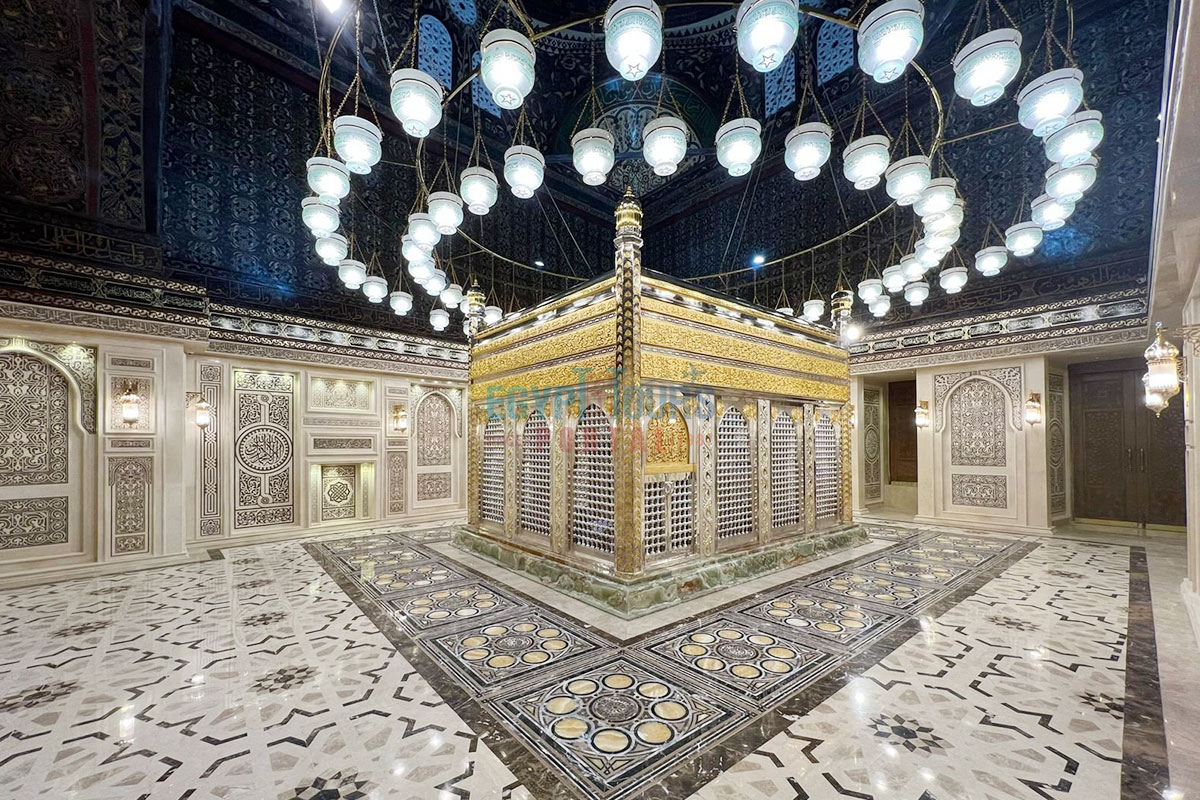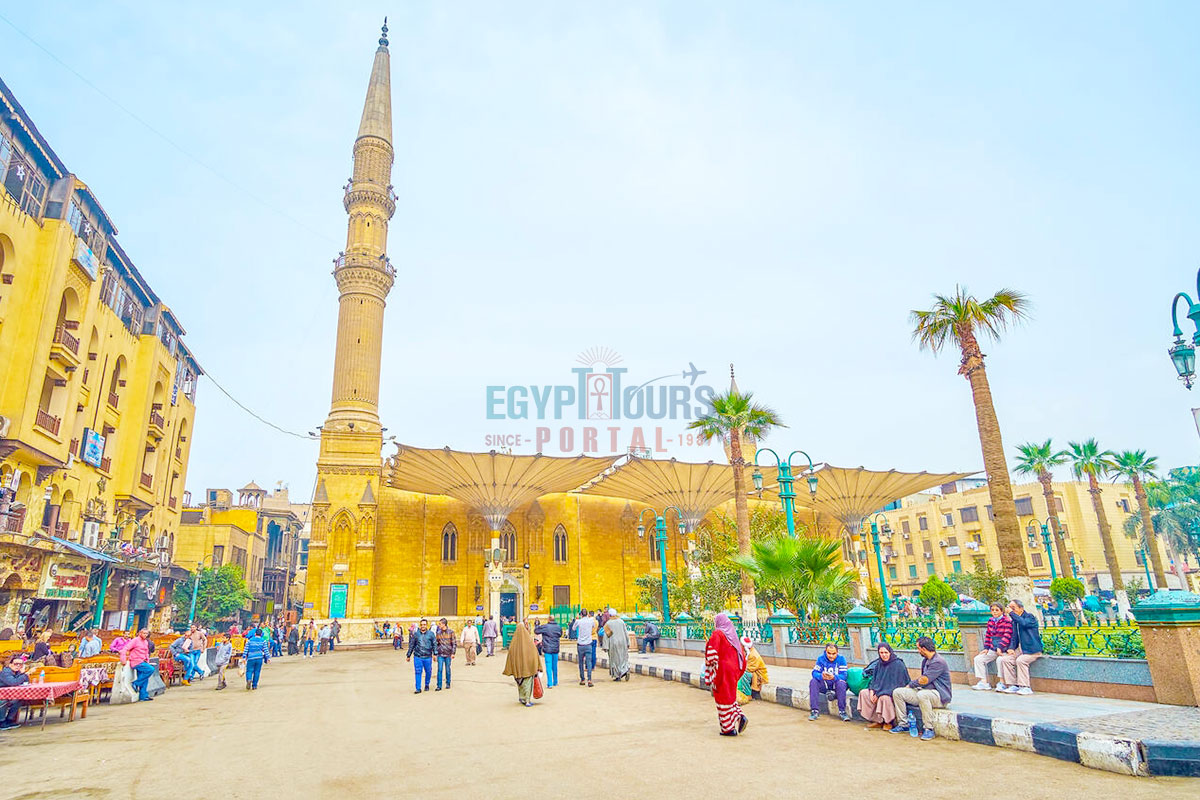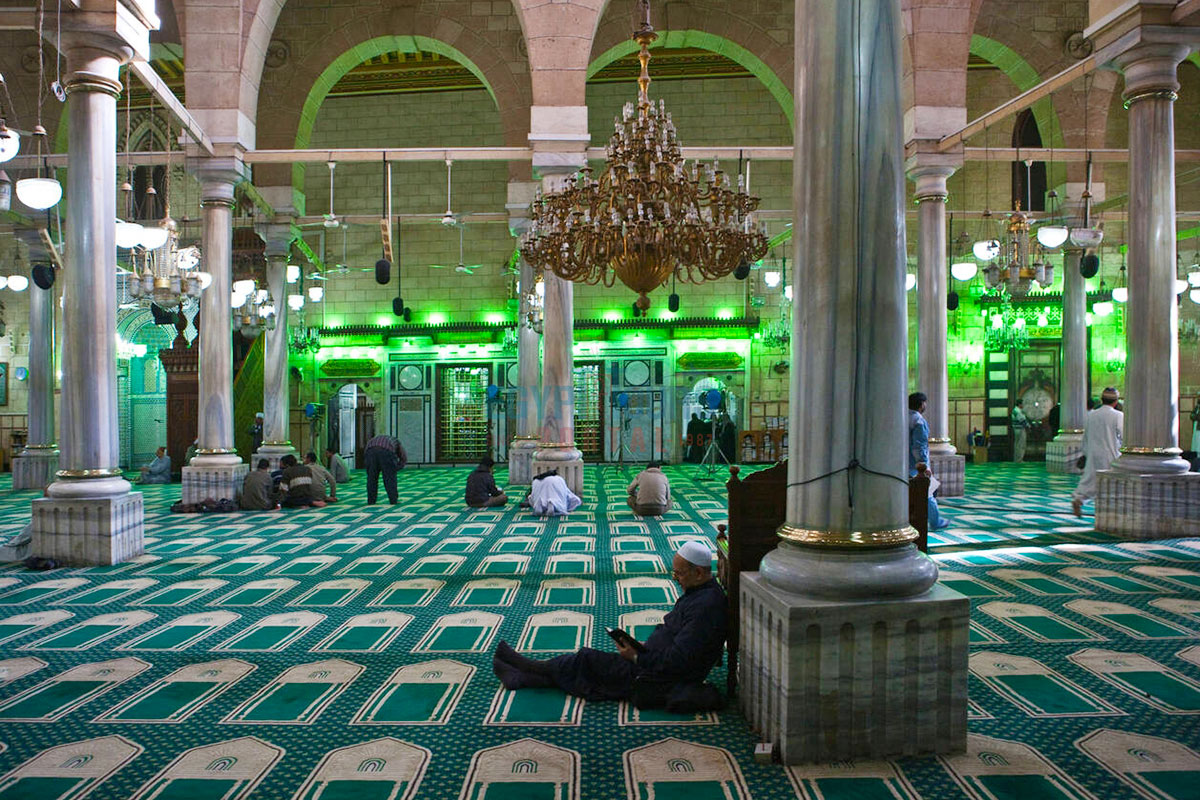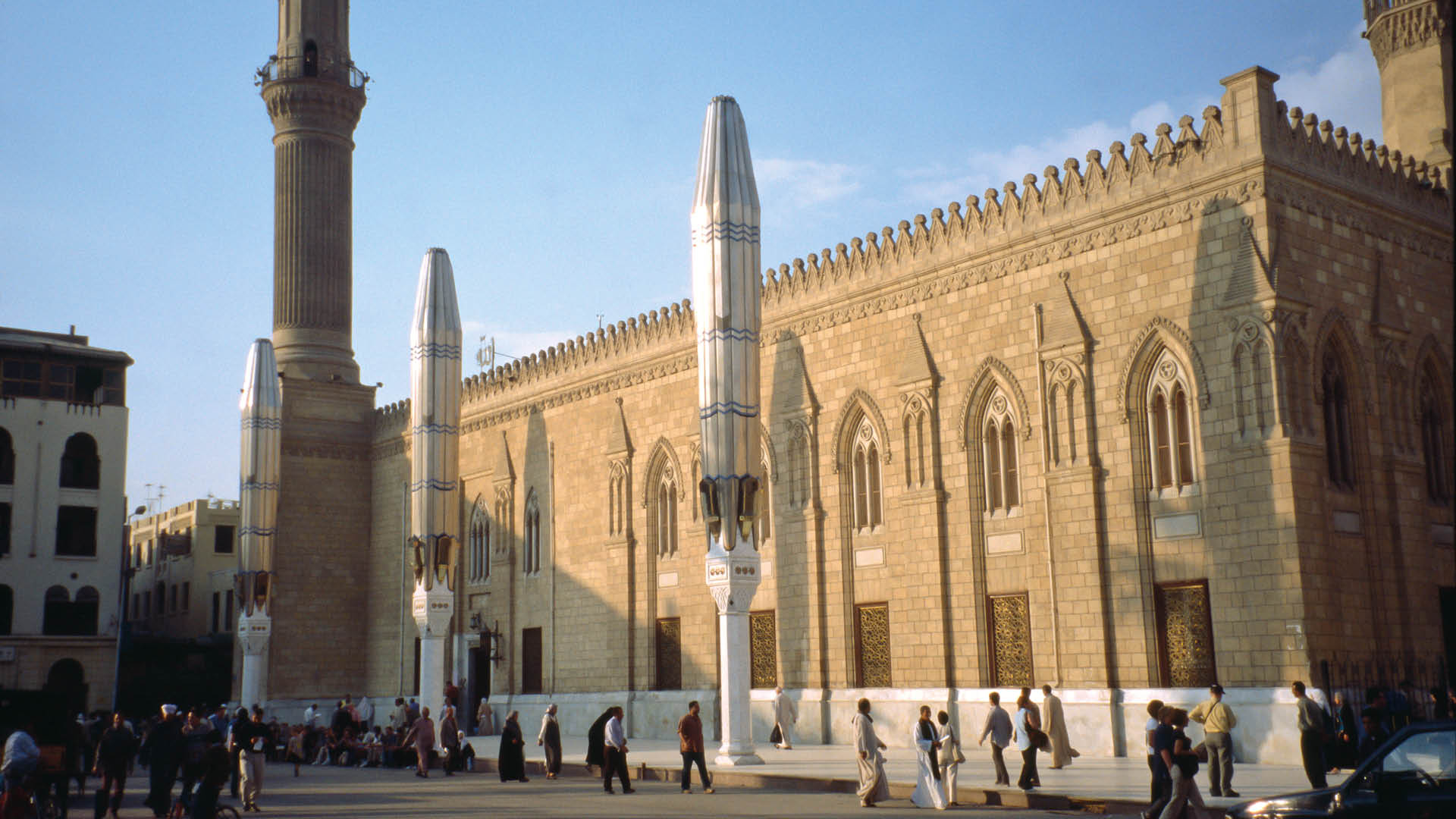Walk in History: Al-Hussein Mosque's Sacred Secrets

Welcome to your guide on the Al-Hussein Mosque in Cairo, Egypt. As you explore this historical site, you will be transported back in time to experience the rich cultural heritage of Egypt.
Overview of Al-Hussein Mosque and its significance in history
Al-Hussein Mosque is located in the heart of Cairo, adjacent to the famous Khan el-Khalili bazaar. This stunning mosque is named after the grandson of the Prophet Muhammad, Al-Hussein, who is revered by Sunni and Shia Muslims.
The mosque is one of the most significant landmarks of Cairo and a must-visit for anyone interested in Islamic history and architecture. It was built in the 12th century by the Fatimid Caliphate, and subsequently renovated and expanded by the Mamluks, Ottomans, and other rulers of Egypt.
The mosque has a unique and striking design, with its central courtyard surrounded by arcade galleries and adorned with intricately carved wood and marble. The minaret towers over the mosque and is visible from all over the city. The mosque's interior is equally stunning, with its walls adorned with beautiful calligraphy.
In addition to its aesthetic appeal, the Al-Hussein Mosque has significant religious and cultural importance. It is considered one of the holiest places in Cairo and is a site of pilgrimage for Muslims from all over the world.
As you explore the mosque, make sure to take note of its stunning features and soak in the rich culture and history of this magnificent site.

Architecture and Design
As you explore the Al-Hussein Mosque, take a closer look at its stunning architecture and design, which showcase the rich history and culture of Egypt and Islam.
Unique features of Al-Hussein Mosque's construction and layout
The mosque's central courtyard is one of the most striking features of its layout, surrounded by arcade galleries with beautifully detailed wood and marble carvings. The minaret is visible from all over Cairo and the mosque is densely packed with intricate details, such as the wooden cupola covering the tomb of Al-Hussein. The mosque also has a unique design, with each of the four sides differing from the others.
Symbolism and meaning behind the intricate design
The exquisite details of the mosque hold great symbolism and meaning. The geometric patterns and calligraphy on the walls represent the complexities of the Islamic faith, and the use of marble, gold, and wood signifies the importance of the mosque for Muslims. The four sides of the mosque represent the four Caliphs who succeeded Prophet Muhammad, reflecting the importance of their leadership in Islamic history.
Take your time and examine the intricate details of the Al-Hussein Mosque. You'll be amazed at the stories that they tell about the rich cultural heritage of Egypt and its connection to Islam.

History and Founding
As you explore the Al-Hussein Mosque, you'll start to feel a sense of the rich history and culture that surrounds it.
Origins and founding of Al-Hussein Mosque
The mosque was built in the 12th century by the Fatimid Imam Al-Hakim bi-Amr Allah, who reigned from 996 to 1021 AD. The mosque was constructed in honour of his grandson, Al-Hussein, who is believed to have been martyred in 680 AD during the Islamic holy month of Muharram.
The mosque underwent several renovations and expansions, with the most recent reconstruction in 2019. It remains a revered place of worship for Muslims worldwide, attracting thousands of visitors yearly.
Important figures and events associated with the mosque
Throughout its history, the Al-Hussein Mosque has played a significant role in Egypt's cultural and spiritual life and the wider Islamic world.
Over the centuries, many influential figures have visited the mosque, including Saladin, the 12th-century Muslim leader who defeated the Crusaders and retook Jerusalem. The mosque has also been at the centre of several important events in Egyptian history, such as the 2011 revolution when it served as a focal point for anti-government protests.
As you explore the Al-Hussein Mosque, take a moment to reflect on its rich history and the many people whose lives have been touched by this amazing place of worship.

Sacred Artifacts and Treasures
If you're a history buff or simply curious about the Islamic faith, you'll be fascinated by the array of sacred artefacts and treasures located within the Al-Hussein Mosque in Cairo, Egypt.
Holy relics and artefacts located within the mosque
The Al-Hussein Mosque is home to several important relics and treasures Muslims deeply revere.
- The wooden pulpit used by Saladin when he entered Cairo in 1169 AD
- A wooden box said to contain hair from the beard of the Prophet Muhammad
- A manuscript of the Quran believed to date back to the 8th century AD
- A collection of valuable carpets and rugs
Significance and historical context of each treasure
Each treasure contains significant historical and cultural context. The wooden pulpit used by Saladin is believed to have been blessed by the Prophet Muhammad himself and is a symbol of Saladin's reign as a just and merciful leader.
The wooden box containing hair from the beard of the Prophet Muhammad is especially revered by Muslims, as it is believed to contain the blessed relics of the Prophet. The Quran manuscript said to date back to the 8th century AD, is a rare and valuable artifact that provides insights into how the holy text was recorded and transmitted during the early years of Islam.
Finally, the collection of fine carpets and rugs is a testament to the artistic and cultural achievements of the Islamic world. Each carpet is unique and beautiful, showcasing intricate designs and patterns that reflect the diverse influences that have shaped Islamic art over the centuries.
When you visit the Al-Hussein Mosque, take time to appreciate each of these sacred treasures and the deep cultural significance they hold.
The Minbar
When you visit the Al-Hussein Mosque in Cairo, it's impossible not to notice the stunning minbar (pulpit) inside. This intricately designed structure has an important historical and cultural significance worth exploring.
History and significance of the mosque's minbar (pulpit)
The minbar was originally constructed in the 12th century during the Fatimid era and has been rebuilt and restored several times. The mosque's imams and scholars used it as a platform to deliver Friday sermons and other religious speeches.
Aside from its practical use, the minbar also holds a symbolic significance for Muslims. It represents the elevated position of the imam or scholar who delivers the sermon, standing above the congregation to address them. Additionally, the minbar is believed to symbolise Islamic knowledge and wisdom.
Intricate design and symbolism of the minbar
The minbar's design is nothing short of impressive. It is made of intricately carved wood and features several elements that hold special significance. These include:
- Floral and geometric patterns that reflect the Islamic influence on art and architecture
- Arabic calligraphy containing verses from the Quran and other Islamic texts
- Stairs or steps that lead up to the platform, symbolise the ascent to higher knowledge and spirituality
- A canopy or roof that provides shade for the speaker, representing protection and guidance
When you see the minbar up close, appreciate the intricate details and symbolism behind its design. It is a work of art with a deep cultural and religious significance for Muslims worldwide.

Al-Hussein Shrine
When you visit the Al-Hussein Mosque in Cairo, one of the prominent features that will surely catch your attention is the minbar, a beautiful pulpit with rich historical and cultural significance. Let’s look at the Al-Hussein Shrine and discover its importance in the Islamic world.
Overview and history of the Al-Hussein Shrine
The Al-Hussein Shrine is located in the heart of Cairo’s historic neighbourhood and is considered one of the most revered sites in the city. It is the burial place of Prophet Mohammed's grandson, Al-Hussein ibn Ali, who was decapitated in Karbala in modern-day Iraq in 680 AD. The shrine was built in the 12th century during the Fatimid era and has undergone several renovations over the centuries to preserve its beauty.
Significance and the role it plays in the mosque's spiritual practices
The Al-Hussein Shrine holds a special place in the hearts of Egyptian Muslims and is also one of the main attractions for pilgrims from around the world. The mosque is also known as a centre for Islamic learning and spiritual development. The minbar inside the mosque represents the elevated position of imams and scholars who deliver sermons and speeches while standing above the congregation. It also represents attaining higher knowledge and spirituality, which every Muslim seeks. The beautiful floral and geometric patterns and Arabic calligraphy create a spiritual ambience that adds to the mosque's serene atmosphere. The canopy or roof of the minbar provides shade and protection to the speaker, symbolizing guidance and help through attaining spiritual knowledge.
Visiting the Al-Hussein Shrine is an experience that should not be missed for anyone interested in Islamic history and architecture. It offers a glimpse into the rich cultural heritage of Egypt and the Islamic world.
Inspirational Stories and Miracles
Are you ready to be inspired by miraculous stories about the Al-Hussein Shrine in Cairo? Here are some of the most popular ones:
Several inspirational stories and miracles associated with Al-Hussein Mosque
One of the famous stories is about a blind man who visited the shrine and prayed for his sight to be restored. As soon as he finished his prayers, he regained his vision. Another story tells of a woman who was unable to conceive a child but, after praying at the shrine, became pregnant and gave birth to a healthy baby. Many people also visit the mosque to seek help with their financial problems, and it is believed that their hardships are eased or resolved after visiting the shrine.
Significance in Islamic culture
The Al-Hussein Shrine holds great historical significance and plays an essential role in Islamic culture. The mosque is a testimony to the spread of Islam through the Arab world and represents the principles of unity, brotherhood, and equality central to the Islamic faith. Moreover, the shrine and its minbar are inspiring examples of Islamic art and architecture, with intricate designs and calligraphy lending a spiritual and peaceful aura to the mosque.
Whether you are seeking spiritual guidance, admiring Islamic architecture, or just curious about Islamic history, visiting the Al-Hussein Shrine is an experience not to be missed. It holds a special place in the hearts of Muslims worldwide and continues to inspire and instil faith in the hearts of many.

Visit Al-Hussein Mosque
If you're looking for a place to visit that's deeply rooted in Islamic history and culture, Al-Hussein Mosque is a perfect destination. Here are some practical tips for visiting this significant and inspiring site:
Practical information about visiting Al-Hussein Mosque
- Location: The mosque is in the heart of Cairo, Egypt, next to the Al-Azhar Mosque.
- Hours: The mosque is open daily from early morning until late night.
- Admission: Admission to the mosque is free of charge.
- Guided tours: Guided tours of the mosque are available for a fee.
Dress code, hours, and guidelines for visitors
- Dress code: Visitors should dress modestly and remove their shoes before entering the mosque.
- Hours: The mosque can get crowded during peak visiting hours, so it's best to plan your visit during non-peak hours.
- Guidelines: Be respectful of the mosque and those who are praying. Keep your voice low, and turn off your phone. Photography is allowed, but be mindful of the people around you.
Whether you're interested in Islamic art and architecture, seeking spiritual guidance, or want to learn more about Islamic culture, Al-Hussein Mosque is a must-visit destination. Be sure to follow the guidelines and dress code and soak in this incredible site's rich history and vibrant energy.
Visit Al-Hussein Mosque
If you're looking for a place to visit that's deeply rooted in Islamic history and culture, Al-Hussein Mosque is a perfect destination. Here are some practical tips for visiting this significant and inspiring site:
Practical information about visiting Al-Hussein Mosque
- Location: The mosque is in the heart of Cairo, Egypt, next to the Al-Azhar Mosque.
- Hours: The mosque is open daily from early morning until late night.
- Admission: Admission to the mosque is free of charge.
- Guided tours: Guided tours of the mosque are available for a fee.
Dress code, hours, and guidelines for visitors
- Dress code: You should dress modestly and remove your shoes before entering the mosque.
- Hours: The mosque can get crowded during peak visiting hours, so it's best to plan your visit during non-peak hours.
- Guidelines: Be respectful of the mosque and those who are praying. Keep your voice low, and turn off your phone. Photography is allowed, but be mindful of the people around you.
Whether you're interested in Islamic art and architecture, seeking spiritual guidance, or want to learn more about Islamic culture, Al-Hussein Mosque is a must-visit destination. Don't miss out on the opportunity to witness this incredible site's rich history and vibrant energy.
Overview of Al-Hussein Mosque and its significance in history
Al-Hussein Mosque is a historic landmark that has been around since the 12th century. It is named after Husayn ibn Ali, the grandson of Prophet Muhammad, and is considered one of Islam's holiest sites. Many people come to the mosque to pay their respects to Husayn ibn Ali and to seek spiritual guidance.
Final thoughts and reflections.
You'll leave Al-Hussein Mosque feeling inspired and enlightened. The energy and history of this important landmark are palpable, and the beauty of the architecture is breathtaking. Follow the guidelines and dress code to respect the mosque and its visitors. Enjoy your visit!
